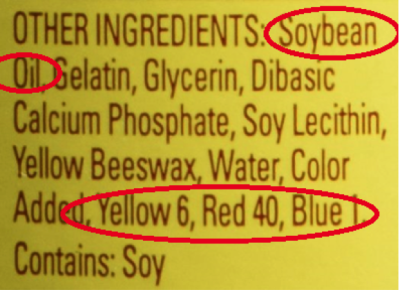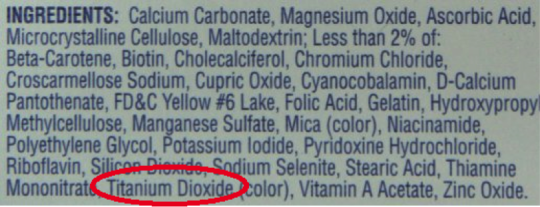
Toxins Found in This Common Pill (and the FDA Knows It)
- The FDA’s lack of concern for consumer health is a hard pill to swallow
- Is your DNA being mutated every time you pop a pill? Find out…
- Three quick steps to keep inflammation, heart disease, and diabetes out of your health regime.
Dear Reader,
Most folks don’t mind parting with a little cash for products they think may improve or ensure their health.
But the problem is some products are doing more harm than good.
In fact, you may have a few examples of these products around your house — I know I do.
I have tried everything from Himalayan salt lamps to detoxing foot pads to boost my health.
While most people don’t go to these extremes to keep their health in check, there is a product that over half of Americans purchase with the hope for better health.
And they pay for it — in more ways than one.
According to the National Institutes of Health, Americans spend an estimated $5.7 billion every year on just this one pill .1
The problem is it comes at more than just a monetary cost to the consumer.
You see, this product can be full of worthless and even dangerous fillers and additives. We will reveal some of the toxic additives in a bit and of course how to avoid them.
But to be clear, most capsules have fillers, but not all fillers are dangerous. Just the ones with proven negative health outcomes.
In the best case, these fillers add no nutritional value. At worst, they a can contribute to serious health risks like heart disease, diabetes, inflammation, and even DNA damage.
And since the FDA has approved these fillers for use in foods, drugs, and supplements, it isn’t going to save you, either.
Instead, it will sit on the sidelines while these “healthy” little pills bring in the billions and the manufacturers keep throwing toxins into them.
![]() So what are these risky remedies?
So what are these risky remedies?
Multivitamins.
Today, we will share with you three of the health dangers tucked away in your everyday pills and share ways to avoid them.
But first, let’s get to the dangers…
![]() Heath Danger #1: Artificial Colors
Heath Danger #1: Artificial Colors
Many gummy vitamins — for both children and adults — have artificial colors in them.

The list of ingredients for a popular kids gummy vitamin.
Source: Amazon.com
You may be wondering: What are artificial colors doing in my vitamins?!?
Well, the FDA (which approves the use of synthetic colors in foods as well) reports the following explanations for why artificial colors are in your vitamins:
1) To offset color loss due to exposure to light, air, temperature extremes, moisture, and storage conditions; 2) correct natural variations in color; 3) enhance colors that occur naturally; 4) provide color to colorless and “fun” foods. 2
I’m not sure why anyone’s vitamin needs to be “fun.” But the bigger concern here is that these artificial colors could be masking the degradation of active ingredients due to moisture, light, or heat.
Plus, the FDA once investigated the link between Red #40 and ADHD in kids but hasn’t acted. However, the European Union has already issued warning labels for six artificial colors because of their link to ADHD.3,4 Not to mention other artificial colors have been linked to cancers in the past.4
You might think these reasons would be enough for the FDA to ban this synthetic garbage from making its way in to any product, yet artificial colors are still in countless foods and vitamins.
Thanks, FDA.
However, artificial colors might be the least of your worries. This next filler has a reputation for wreaking havoc on your health.
![]() Health Danger #2: Hydrogenated Oils and GMOs
Health Danger #2: Hydrogenated Oils and GMOs
All types of vitamins — capsules, tablets, softgels, and gummies — may have hidden hydrogenated oils (and partially hydrogenated oils) or GMO products hidden in them. These include corn and soybean oils.

Soybean oil and artificial colors are found in this adult daily multivitamin.
Source: Amazon.com
Partially hydrogenated oils, aka trans fats, can lead to a whole host of dangerous health problems including heart disease, stroke, inflammation, diabetes, and other chronic conditions, because they raise your low-density lipoprotein (LDL), or “bad” cholesterol, levels.5
And even if the soybean or corn oil in your multivitamin isn’t hydrogenated, it’s almost certainly GMO if you aren’t choosing an organic or GMO-free source.
We all know GMO’s are bad, but they may not be as scary as the next nasty toxin…
Metal.
![]() Health Danger #3: Titanium Dioxide
Health Danger #3: Titanium Dioxide
Titanium dioxide is often used as a coloring agent in both supplements and cosmetics. However, this pigment comes at grave health costs.

Titanium dioxide is listed as an ingredient in a popular multivitamin tablet.
Source: Amazon.com
This naturally occurring metal can cause lung inflammation and immune system issues in workers during production.6 And while exposure from taking a pill isn’t as drastic as that from working with it, you have to wonder what it might be doing to your body.
As it turns out, it may be doing a lot.
One study shows titanium dioxide can create a small amount of DNA damage. This means you’re getting a tiny dose of DNA damage every time you pop a vitamin.7
Yikes!
Yet again, our health is jeopardized for the aesthetics of supplements. I think I would rather swallow an ugly pill than damage my genetic code.
But since pretty pills sell, you need to make a few changes when buying supplements. Here are few things you can do to protect yourself…
![]() Vitamin Solutions
Vitamin Solutions
It’s pretty obvious the FDA is doing more to protect the big food suppliers than, you know, the food supply (of which supplements are technically a part) from these dangerous additives, so it’s up to you to find safe vitamins and supplements.
Here are a few ways to do that:
- Check the labels — if you see that your vitamin has addition color, make sure it’s from a vegetable source. Also be sure to look for an organic or GMO-free label to ensure you’re not consuming GMO oils or other GM products.
- Reach out to your supplement company and ask them about their ingredients. You can do this through their website or consumer hotline (always look for the number on the bottle before you purchase).
- Eat a variety of organic vegetables, fruits, and meats to get as many vitamins and nutrients as possible.
Live well,

Natalie Moore
Managing editor, Living Well Daily
P.S. Do you have supplement questions you would like answered? Send them in! We would love to answer them for you. Direct all questions to nmoore@lfb.org
Sources
[1] Multivitamin/mineral Supplements
[3] FDA Probes Link Between Food Dyes, Kids’ Behavior
[4] Living in Color: The Potential Dangers of Artificial Dyes
[5] Shining the Spotlight on Trans Fats
[6] Effects of Th1 and Th2 cells balance in pulmonary injury induced by nano titanium dioxide.
Written By Natalie Moore
Natalie Moore is a dedicated health researcher with a passion for finding healthy, natural, and science-based solutions. After a decade of direct healthcare experience in western and natural medicine, she was involved in public health research before joining Living Well Daily.
View More Free Articles
Repair Your Gut Barrier With the “Sunshine Cure”
Happy Fourth of July! As you celebrate with sunshine, good food, and great company, don’t forget—those summer rays aren’t just lifting your spirits… they’re also working behind the scenes to protect your gut and boost your health. Your gut health is more important than most people realize. It directly affects your overall well-being—from immunity to...
The 5 Health Numbers Your Doctor Wishes You'd Track
Have you ever been told you should “advocate” for yourself when it comes to your healthcare and wondered what that really means? It’s not just a buzzword—it’s a powerful concept that empowers you to take charge of your own health journey. In fact, it could save your life. Being your own best health advocate starts...
Do THIS Every 20 Minutes to STOP Digital Eye Strain
Our eyes are under assault—they are the true victims of our current digital age. And it’s because we are constantly glued to screens… phones, tablets, computers, TVs—you name it. Unfortunately, that screen time is taking a serious toll. Digital eye strain affects millions worldwide. In fact, up to 50 percent of computer users could develop...
Mailbag: The Calcium Mistake That's Hardening Your Arteries
“What type of calcium is best to take with bisphosphonates for osteoporosis? I know some varieties can build up in arteries. Thanks for the help.” —Bone Builder Hi Builder, When a patient asks me about calcium, I ask them a peculiar question in return… “Ever wonder how elephants and giraffes build and maintain their massive...
Doctor-Approved Method to Ditch Blood Pressure Meds
In a world where drug solutions dominate healthcare, it’s refreshing to discover that best remedies sometimes don’t involve a single pill. A groundbreaking study shows simple relaxation techniques could be your secret weapon against one of America’s deadliest health conditions. Best of all? It’s free, easy to start right away—and your results are bound to...
Trouble Hearing? Your Heart Could Be at Risk
With research exploding and data pouring in, scientists are uncovering some weird (and surprisingly helpful) health connections. Today’s odd couple? Hearing loss and heart failure. Turns out your ears and your ticker are more connected than you ever imagined. A major study published in the journal Heart looked at over 164,000 people for nearly a...
Stay Up Late? It Could Destroy Your Mental Health
If you dread mornings but come alive at night, there’s concerning new research you need to know about. A recent study found that “night owls” are at higher risk for depression. But before you rush to set your alarm to get up with the sun tomorrow, there’s more to the story… Chronotypes are essentially your...
Go from Flabby to Fit with this Common Vitamin
If you’re like many of us, you woke up one day, looked in the mirror, and realized you’re no spring chicken anymore. Even worse—when you weren’t paying attention—it seems you somehow misplaced the muscles of your youth and have gone from fit to flabby. Aging has a way of humbling us like that. But scientists...
Seasonal Allergy “Off Switch” Discovered in the GUT
“Doc, why am I suddenly suffering from seasonal allergies when I’ve never had them before?” It’s a question I get all the time—and my answer might surprise you. Stop looking up at the trees—and start looking down at your gut… Your sneezing fits, itchy eyes, and runny nose might have more to do with what’s...
“Canary in the Coal Mine” Test Sniffs Out Brain Issues Early
One of the most common questions I get is how to tell if you’re starting to experience cognitive decline. I get it—losing your memory is scary, especially when it sneaks up on you. But here’s some exciting news that might put your mind at ease. A fascinating new study suggests that your nose might be...









